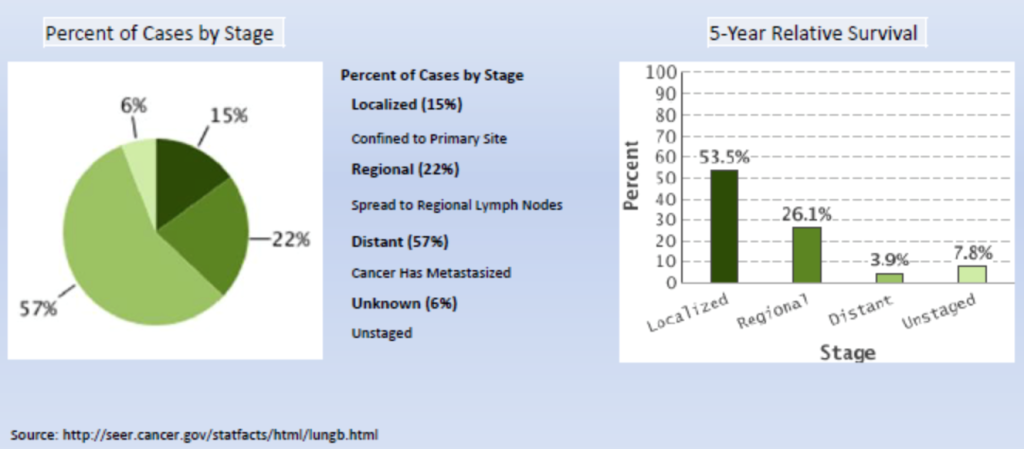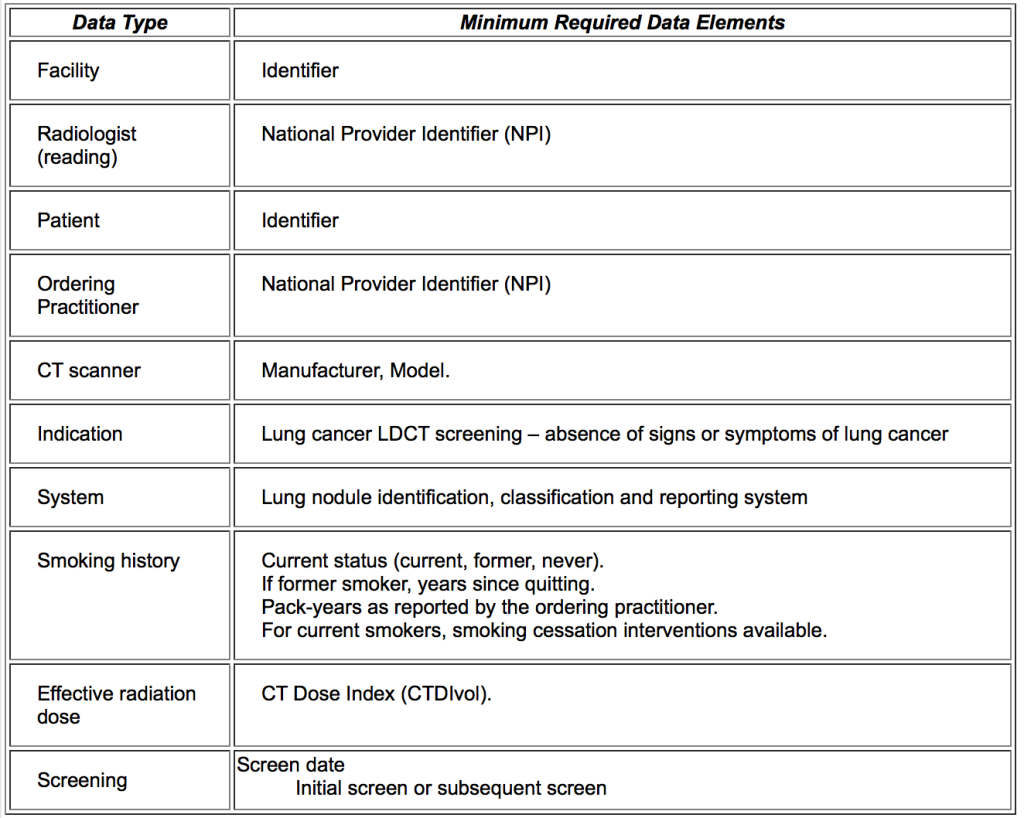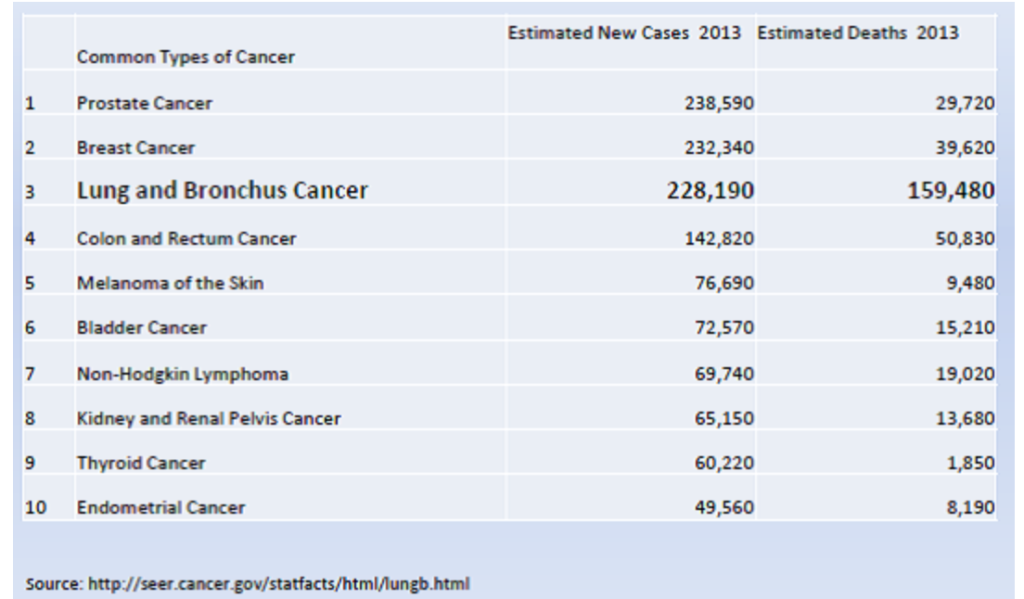Do Any of Your Medicare Patients Meet the Newly Approved Lung Cancer Screening Requirements With Low Dose Computed Tomography (LDCT)?
Lung cancer is the leading cause of cancer deaths in the United States and third in overall cancer incidence according to 2013 National Cancer Institute statistics. Fortunately, newly approved preventive service for annual lung cancer screening is available for Medicare beneficiaries meeting certain eligibility criteria.
This increased availability and accessibility to screening should ultimately affect the mortality rates. Although mortality rates due to lung and bronchus cancer have been decreasing, 57% of the new cases still have distant metastases at diagnosis. (NIH/NCI/SEER 2013) The 5-year survival rates are clearly much better for early detection and localized disease.

According to the Prosch and Schaefer-Prokop March 2014 review of randomized controlled trials, The National Lung Screening Trial (NLST) provided statistical evidence that LDCT screening reduced lung cancer mortality by 20%. However, this review also recognized the lack of data analysis regarding over-diagnosis, false positive results and effect of radiation dose.
The following are the strict criteria for the National Coverage Determination requirements regarding the beneficiary, the reading radiologist and the imaging facility.
Beneficiary eligibility criteria:
- Age 55 – 77 years
- Asymptomatic (no signs or symptoms of lung cancer);
- Tobacco smoking history of at least 30 pack-years (one pack-year = smoking one pack per day for one year; 1 pack = 20 cigarettes);
- Current smoker or one who has quit smoking within the last 15 years; and
- Receives a written order for LDCT lung cancer screening that meets the following criteria:
o For the initial LDCT lung cancer screening service: a beneficiary must receive a written order for LDCT lung cancer screening during a lung cancer screening counseling and shared decision making visit, furnished by a physician (as defined in Section 1861(r)(1) of the Social Security Act) or qualified non-physician practitioner (meaning a physician assistant, nurse practitioner, or clinical nurse specialist as defined in §1861(aa)(5) of the Social Security Act). A lung cancer screening counseling and shared decision making visit includes the following elements (and is appropriately documented in the beneficiary’s medical records):
- Determination of beneficiary eligibility including age, absence of signs or symptoms of lung cancer, a specific calculation of cigarette smoking pack-years; and if a former smoker, the number of years since quitting;
- Shared decision making, including the use of one or more decision aids, to include benefits and harms of screening, follow-up diagnostic testing, over-diagnosis, false positive rate, and total radiation exposure;
- Counseling on the importance of adherence to annual lung cancer LDCT screening, impact of comorbidities and ability or willingness to undergo diagnosis and treatment;
- Counseling on the importance of maintaining cigarette smoking abstinence if former smoker; or the importance of smoking cessation if current smoker and, if appropriate, furnishing of information about tobacco cessation interventions; and
- If appropriate, the furnishing of a written order for lung cancer screening with LDCT.
o For subsequent LDCT lung cancer screenings: the beneficiary must receive a written order for LDCT lung cancer screening, which may be furnished during any appropriate visit with a physician (as defined in Section 1861(r)(1) of the Social Security Act) or qualified non-physician practitioner (meaning a physician assistant, nurse practitioner, or clinical nurse specialist as defined in Section 1861(aa)(5) of the Social Security Act). If a physician or qualified non-physician practitioner elects to provide a lung cancer screening counseling and shared decision making visit for subsequent lung cancer screenings with LDCT, the visit must meet the criteria described above for a counseling and shared decision making visit.
o Written orders for both initial and subsequent LDCT lung cancer screenings must contain the following information, which must also be appropriately documented in the beneficiary’s medical records:
o Beneficiary date of birth
- Actual pack – year smoking history (number)
- Current smoking status, and for former smokers, the number of years since quitting smoking;
- Statement that the beneficiary is asymptomatic (no signs or symptoms of lung cancer); and
- National Provider Identifier (NPI) of the ordering practitioner.
Reading radiologist eligibility criteria:
- Board certification or board eligibility with the American Board of Radiology or equivalent organization;
- Documented training in diagnostic radiology and radiation safety;
- Involvement in the supervision and interpretation of at least 300 chest computed tomography acquisitions in the past 3 years;
- Documented participation in continuing medical education in accordance with current American College of Radiology standards; and
- Furnish lung cancer screening with LDCT in a radiology imaging facility that meets the radiology imaging facility eligibility criteria below.
Radiology imaging facility eligibility criteria:
- Performs LDCT with volumetric CT dose index (CTDIvol) of ≤ 3.0 mGy for standard size patients (defined to be 5’ 7” and approximately 155 pounds) with appropriate reductions in CTDIvol for smaller patients and appropriate increases in CTDIvol for larger patients;
- Utilizes a standardized lung nodule identification, classification and reporting system;
- Makes available smoking cessation interventions for current smokers
Collects and submits data to a CMS-approved registry for each LDCT lung cancer screening performed. The data collected and submitted to a CMS-approved registry must include, at minimum, all of the following elements:

CMS will evaluate the entities interested in becoming CMS approved registries based on the requirements outlined in the National Coverage Determinations.
For those Medicare beneficiaries meeting eligibility criteria, the counseling and shared decision making visit with the physician or qualified non-physician practitioner should address the risks and benefits of a lung cancer screening program and determine if the individual would ultimately benefit from participation.


